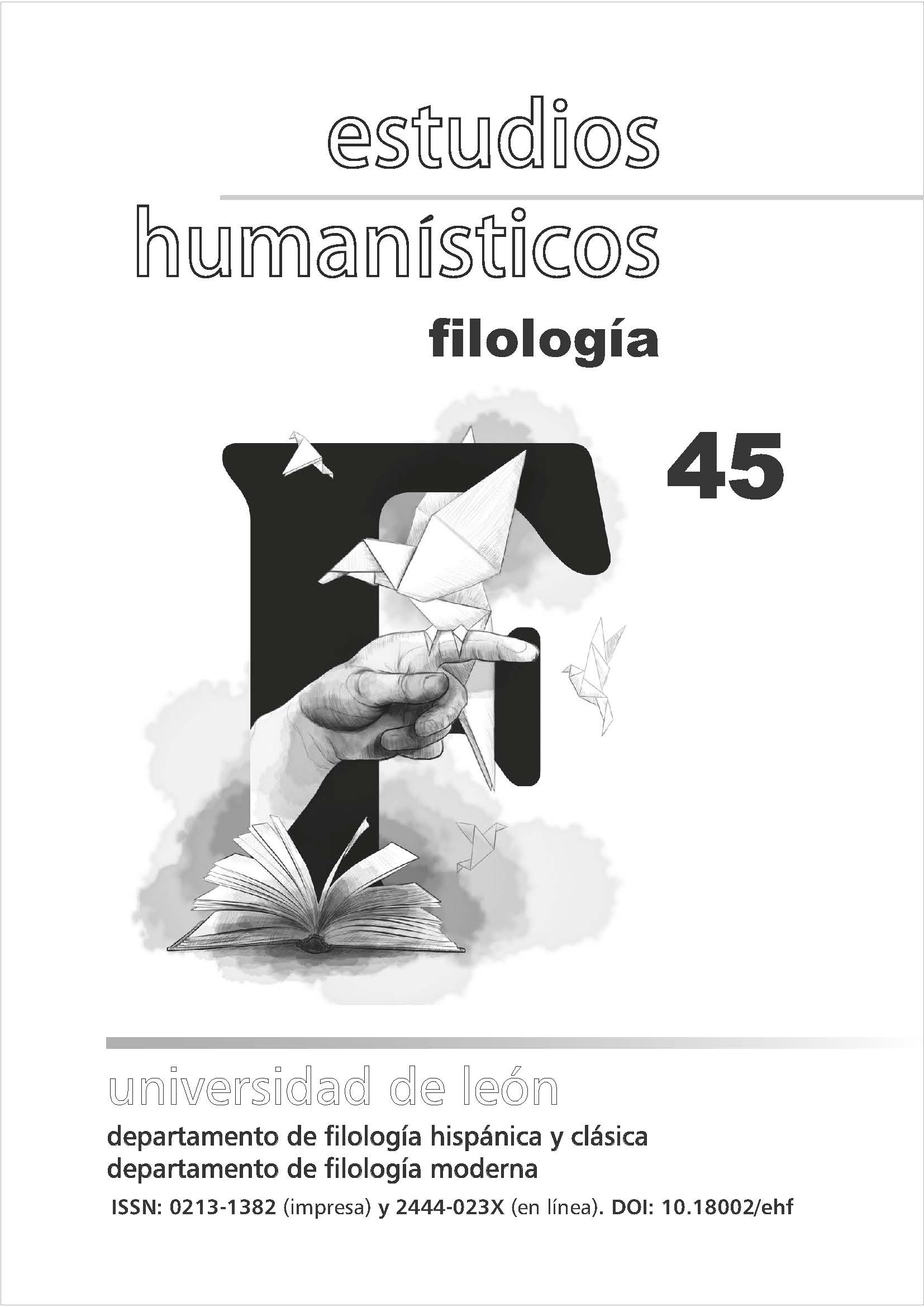Imágenes de la teratología femenina en dos cuentos de E. A. Poe
"Ligeia" y "Morella" según B. Lacombe
DOI:
https://doi.org/10.18002/ehf.i45.7615Palabras clave:
E. A. Poe, Benjamin Lacombe, Relato, Monstruosidad, IlustraciónResumen
El ilustrador contemporáneo Benjamin Lacombe ilustró la década pasada una selección de relatos de E. A. Poe (1809–1849). De entre todas las obras pictóricas que elaboró, este trabajo selecciona las ilustraciones de “Ligeia” y “Morella”, dos de los cuentos más aclamados del norteamericano, donde las protagonistas son vistas por el artista como seres monstruosos y malignos. Lacombe decide aplicar una lectura que sugiere que la perversidad y lo macabro proceden de las figuras femeninas. Las mujeres de las historias son representadas como criaturas perversas y quiméricas, fruto tanto de la herencia artística surrealista de Lacombe como del imaginario gótico de E. A. Poe, que ofrecen la posibilidad de entender la figura femenina como amenazante y teratológica.
Palabras clave: E. A. Poe, Benjamin Lacombe, relato, monstruosidad, ilustración
Descargas
Métricas alternativas
Citas
Anderson, J. (2014): The Dying Woman Tales of Edgar Allan Poe: Parables of the Interdependence of Body and Soul. Trabajo de fin de máster, Universidad de Harvard.
Biedermann, H. (1993): Diccionario de símbolos. Barcelona, Paidós.
Bornay, E. (1998): Las hijas de Lilith. Madrid, Cátedra.
Bronfen, E. (1996): Over her Dead Body. Death, Feminity and the Aesthetic. Manchester University Press.
Chen, P–Y. (2018): “The Ethical Aspect of Disease: Poe’s ‘Morella’ and Life”. Concentric: Literary and Cultural Studies, 41–60.
Cirlot, J. E. (2022): Diccionario de símbolos, Madrid, Siruela.
Clarke, H. (ilust.) (1923): Tales of Mystery and Imagination by Edgar Allan Poe. With Illustrations by Harry Clarke. Nueva York, Brentano’s.
González Moreno, F. y Rigal Aragón, M. (2020): “The Pictorial Richness of Poe’s Oeuvre”, en González Moreno, B. y González Moreno, F. (eds.) (2020): Painting Words. Aesthetics and the Relationship between Image and Art, Londres, Routledge, 93–112.
Holubetz, M. (1986): “Death–Bed Scenes in Victorian Fiction” English Studies: A Journal of English Language and Literature, 67, 14–34.
Keats, J. (2021): Poemas escogidos. Edición bilingüe de J. V. Martínez Luciano et. al. Madrid, Cátedra Letras Universales.
Kennedy, J. G. (1987): Poe, Death, and the Life of Writing. Yale University Press.
Lacombe, B. (ilust.) (2011): Edgar Allan Poe. Cuentos macabros. Volumen I. Madrid, Edelvives.
Lacombe, B. (ilust.) (2018): Edgar Allan Poe. Cuentos macabros. Volumen II. Zaragoza, Edelvives.
Lee, C. (2015): “The Treachery of the Persistence of Memory: An Analysis of the Manipulative Narrator of Edgar Allan Poe’s ‘Ligeia’”, Criterion: A Journal of Literary Criticism, 8, 9–17.
Lorandi, M. (Ed.) (1984): Alberto Martini illustratore di Edgar Allan Poe, Milán, Ed. Franco Maria Ricci.
Markus, R. (1978): “Surrealism’s Praying Mantis and Castrating Woman”. Woman's Art Journal, 21, nº. 1, 33–39.
Mesa Villar, J. M. (2009): “I Drew her Gaze as Simply as my Breath: The Influence of Edgar Allan Poe’s Revenants upon Dante Gabriel Rossetti’s Mystical Maiden Profile”. The Grove, 16, 129–150.
Ostrom, J. W. (1966): The Letters of Edgar Allan Poe. Vols. I y II. Nueva York, The Gordian Press.
Poe, E. A. (1848): Eureka: A Prose Poem. Nueva York: Geo P. Putnampp, 7–22.
Poe, E. A. (1978): “Ligeia”, en Mabbott, T. O. (Ed.) Edgar Allan Poe. Tales & Sketches. Volume I, 305–334.
Poe, E. A. (1978): “Morella”, en Mabbott, T. O. (Ed.) Edgar Allan Poe. Tales & Sketches. Volume I, 221–237.
Poe, E. A. (2011): Edgar Allan Poe. Cuentos macabros. Vol. I. Madrid, Edelvives.
Poe, E. A. (2018): Edgar Allan Poe. Cuentos macabros. Vol. II. Madrid, Edelvives.
Rackham, A. (ilust.) (1935): Tales of Mystery and Imagination. Londres, Ed. George G. Harrap and Co.
Raitt, J. (1980): “The ‘Vagina Dentata’ and the "Immaculatus Uterus Divini Fontis”. Journal of the American Academy of Religion, 48, n. º 3, 415–431.
Reina Valera (1960): Nuevo Testamento. Tenessee, Ed. Vida.
Webb, J. (2011): “Fantastic Desire: Poe, Calvino, and the Dying Woman”. The Comparatist, 35, 211–220.
https://www.youtube.com/watch?v=MJnS2HYKllM&t=72s&ab_channel=hoyesarte (vídeo entrevista con motivo de la exposición de Benjamin Lacombe en el museo ABC, 2013. Consultado en julio de 2023).
https://www.youtube.com/watch?v=m1MxZNF8AwU&ab_channel=EdelvivesEditorial (clase magistral “El universo de Benjamin Lacombe” (parte 1) en el museo ABC, 2013. Consultado en julio de 2023).
https://www.eapoe.org/works/index.htm (Página web oficial de The Edgar Allan Poe Society of Baltimore, consultada en febrero de 2023).
http://www.poeonline.es/es/ (Página web del grupo de investigación LyA, consultada en febrero de 2023).
Descargas
Publicado
Cómo citar
Número
Sección
Licencia
Derechos de autor 2023 Gema Martínez Ruiz

Esta obra está bajo una licencia internacional Creative Commons Atribución-NoComercial-CompartirIgual 4.0.
Los autores o autoras que publican en esta revista están de acuerdo con los siguientes términos:
- Los autores o autoras conservan los derechos de autoría de su trabajo y ceden de forma no exclusiva los derechos de explotación (reproducción, distribución, comunicación pública, transformación) a la Universidad de León, por lo que pueden establecer, por separado, acuerdos adicionales para la distribución no exclusiva de la versión de la obra publicada en la revista (por ejemplo, alojarlo en un repositorio institucional o publicarlo en un libro), con un reconocimiento de su publicación inicial en esta revista.
- Este trabajo se encuentra bajo la Creative Commons Attribution-NonCommercial-ShareAlike 4.0 International License. Puede consultarse desde aquí la versión informativa y el texto legal de la licencia.
- Se permite y se anima a los autores y autoras a difundir electrónicamente las versiones pre-print (versión antes de ser evaluada) y/o post-print (versión evaluada y aceptada para su publicación) de sus obras antes de su publicación, ya que favorece su circulación y difusión más temprana y con ello un posible aumento en su citación y alcance entre la comunidad académica.











